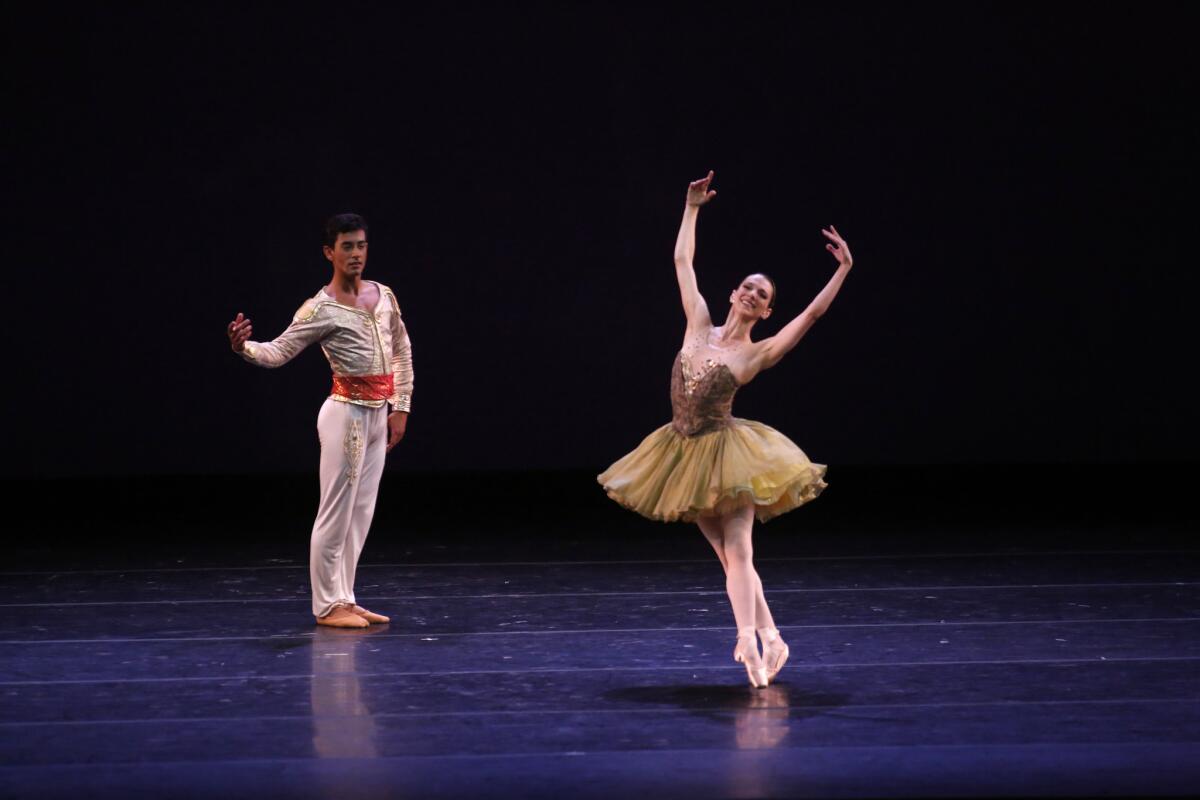Review: BalletNow gets Dorothy Chandler audience on its feet

Kleber Rebello from Brazil and Luciana Paris from Argentina perform Saturday night at the Dorothy Chandler Pavilion as part of BalletNow.
- Share via
Bring together two celebrity danseurs, give them each gala-style programs, add 17 of their most talented friends, and — voila — you have an audience-pleasing formula that stoked some well-deserved ovations this weekend at the Dorothy Chandler Pavilion.
BalletNow, which was co-produced by the Music Center, was an intriguing Rorschach test of its artistic directors, Roberto Bolle and Herman Cornejo.
The Italian-born Bolle is an elegant star with American Ballet Theatre and La Scala Ballet in Italy, a real-life David with dark hair, pale skin and a perfectly proportioned and chiseled body; off came the shirt in each of his four numbers. He looks as good standing still as moving, which is undeniably an asset but can be a crutch too.
The Argentine-born Cornejo, a longtime ABT principal, is a charismatic artist with unmatched rhythmic acuity. His body is living, pulsing music. Add to this innate gift his athleticism, and he owns the stage.
Each man picked 10 classical and contemporary works for his program -- Bolle’s on Friday and Cornejo’s on Saturday (with a Sunday show mixing elements of both). Most were performed to recorded music.
Bolle’s Friday night selection included largely European dancers and choreographers. Some pieces were familiar, such as George Balanchine’s crystalline “Tchaikovsky Pas de Deux” from 1960 (jauntily executed by Maria Kochetkova and Joan Boada despite a dreadful recording) and the third-act pas de deux from John Neumeier’s 1978 “Lady of the Camellias” (in a stunningly emotive reading by Lucia Lacarra and her Munich colleague Marlon Dino).
There were unfamiliar ones too, such as Itzik Galili’s crisp and gymnastic “Mono Lisa” (2003) and Marco Goecke’s searing but repetitive ode to Johnny Cash called “Affi” (2005).
Among the dancers rarely seen here were Dutchman Marijn Rademaker, an edgy presence in “Affi”; and Kazakhstan’s sensuous Maria Eichwald, who was paired with Rademaker in Hans Van Manen’s mesmerizing “Trois Gnossiennes” (1986), a love duet to Satie that derives its power in stark simplicity. It was joyous to watch the luscious full movement of Lacarra. She and Dino brought heightened honesty to Ben Stevenson’s barre ballet from 1969, “Three Preludes.”
Bolle showed off his clean and secure style in a pas de deux from “Excelsior,” an updated version of a 19th century circus-like Italian warhorse; he, in a loincloth, portrayed Slavery, while charming partner Petra Conti was Civilization. Bolle as sex symbol was the focus of two pieces created for him, both with videos: “Passage,” a work of yearning and loss by Marco Pelle (2014) and the closing number, “Prototype” by Massimiliano Volpini (2013), which was a forgettable bit of pseudo autobiography.
Whereas Bolle mixed art with entertainment, throwing in some kitsch, Cornejo opted for fireworks, delivered by a cast of Southern American and Cuban dancers on Saturday. The crowd gave at least four standing ovations before the concluding one, as the dancers pushed their performances in response to the cheers.
Cornejo gave us a lovely bittersweet, balletic, tango-soft shoe of his own creation, “Tango y Yo.” JP Jofre on bandoneon and Yoni Levyatov on piano played Astor Piazzolla while Cornejo stalked stealthily, his hat serving as a Proustian remembrance of love.
Former ABT dancer Carlos Molina has turned choreographer, and he brought unexpected depth and feeling to that Russian spectacle, “Spartacus.” It certainly helped that he was dancing with his wife, the glorious Boston Ballet principal Erica Cornejo (Herman’s sister), particularly when it came to the heart-stopping overhead lift. Fabulous. The couple were equally searing in the premiere of Molina’s “Carmen” pas de deux.
The other pyrotechnics came from an adaptation of Petipa’s “Don Quixote” grand pas de deux and the pas de trois from “Le Corsaire,” both featuring Herman Cornejo in signature parts. Cuban ballerina Viengsay Valdes was supremely on her game, balancing seemingly forever on point. Mary Carmen Catoya and Kleber Rebello repeated the Balanchine, doing it with far more flair. Luciana Paris enchanted with her gracious manner in Petipa’s “The Talisman” duet with Rebello.
Finally, piling sentiment on top of an already emotional night, ABT’s recently retired Paloma Herrera made her local farewell in a tango-esque piece by Mauricio Wainrot and another by Vicente Nebrada (Juan Pablo Ledo partnered with her, with Levyatov again on piano). In a lovely tradition Los Angeles doesn’t often get to experience, each dancer brought Herrera a single rose, while Cornejo handed her an extravagant bouquet. That’s just the way he is.
More to Read
The biggest entertainment stories
Get our big stories about Hollywood, film, television, music, arts, culture and more right in your inbox as soon as they publish.
You may occasionally receive promotional content from the Los Angeles Times.









